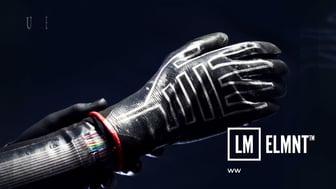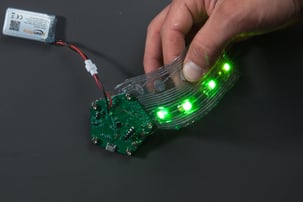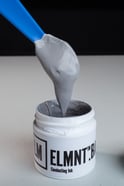ELMNT Ink Solves Touch Sensing Challenge for Virtual Reality
April 12, 2022
 Wearable devices for augmented reality/virtual reality leverage many different sensors that interact with humans and their environment. A simple, yet powerful, interactive sensor is capacitive touch sensing, which requires just an single electrode to detect when a user touches an object through changes in the electrical charge.
Wearable devices for augmented reality/virtual reality leverage many different sensors that interact with humans and their environment. A simple, yet powerful, interactive sensor is capacitive touch sensing, which requires just an single electrode to detect when a user touches an object through changes in the electrical charge.
The challenge in the industry is that capacitive touch can be sensitive to user movement and stretching. As the user moves, capacitive electrodes can prematurely activate, which limits user mobility and confines the immersive experiences.
UES’ new ELMNTTM Liquid Metal Ink solves many of the challenges for capacitive touch sensing. ELMNT ink is not only flexible and robust, but also has the ability to maintain constant electronic properties while stretching with minimal hysteresis.
Capacitive Sensor Arrays with ELMNT Stretchable Ink
 Alex Parkison is a UES scientist fabricating wearable devices. Parkison patterned UES’ ELMNT into capactive sensor arrays and tested its mutual capacitance (several sensors activated at once to determine user location).
Alex Parkison is a UES scientist fabricating wearable devices. Parkison patterned UES’ ELMNT into capactive sensor arrays and tested its mutual capacitance (several sensors activated at once to determine user location).
Parkison showed that ELMNT ink works well for mutual capacitance, even when stretched. Traditional silver and carbon based inks are not capable of achieving this type of sensing sometimes even while just being slightly flexed or under any appreciable amount of strain. The increase in resistance other materials experience really inhibits most sensing applications as well as power and data transmission capabilities.
ELMNT overcomes the challenges of multi touch sensing for a wide variety of applications such as augmented reality, soft robotics, and wearable devices.
Multicapacitance Array Video Demonstration
The video demonstration below displays some of these capabilities under various strains in a bi-axial strain setup. The mutual capacitance array was fabricated using ELMNT.BA ink specially formulated for blade coating over a PET stencil cutout that was produced using a laser cutter and placed onto a TPU substrate. This device was connected to an MSP430FR2676 capacitive touch sensing chip made by Texas Instruments. Using TI's captivate design studio along side code composer studio enabled tuning a wide variety of parameters to get the best performance out of sensors even while under uniaxial and biaxial strain. You can see that the ELMNT.BA sensor responds at multiple strains and cycles, to capacitive touch.
Other Applications
 ELMNT ink and TPU are easily integrated into textiles such as a glove. The low profile of the ELMNT traces makes it comfortable and nearly undetectable to the user. UES continues to look into wearable capacitive touch sensing device to make better tools for pilots in virtual reality training, on-body monitoring, or machine/human interfacing. Contact us at the link below to learn more, or to purchase material for your applications.
ELMNT ink and TPU are easily integrated into textiles such as a glove. The low profile of the ELMNT traces makes it comfortable and nearly undetectable to the user. UES continues to look into wearable capacitive touch sensing device to make better tools for pilots in virtual reality training, on-body monitoring, or machine/human interfacing. Contact us at the link below to learn more, or to purchase material for your applications.
You can learn more about ELMNT and how it can help you solve your flexible electronics challenges. Have particular material challenges you’d like to discuss with our experts? Contact us here.
Questions? Contact us here. Connect with us on Facebook, Twitter, LinkedIn, and Instagram.
